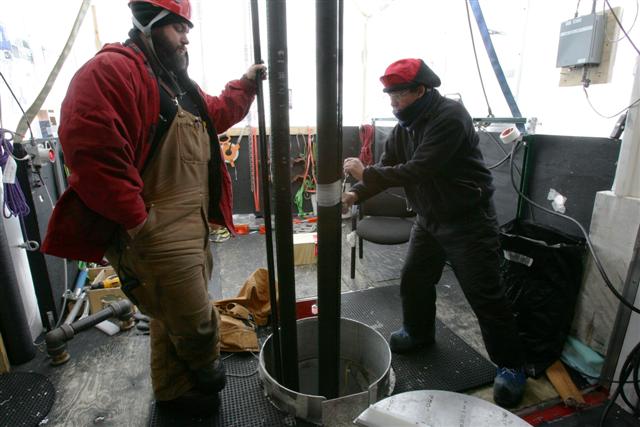Page 2/2 - Posted April 2, 2010
3. What was the most difficult journey that you made for the book and why?You’d think that the most difficult trip was the one to the South Pole. But honestly, after I was selected by the National Science Foundation’s Artists and Writers Program to go to Antarctica, I was in the extremely capable hands of the U.S. Antarctic Program I’d say that the most difficult journey was the trip to Lake Baikal in Siberia. It was one of the earliest trips I made for the book, and I was not on sure footing, literally and figuratively. The lake hosts a gigantic underwater neutrino telescope, and for reasons that I explain in the book, the physicists have to work during the winter, when the lake is frozen over. The trip took a while to arrange, and the physicists helped me do all the paperwork to get to Russia (the applications were all in Russian). The flight to Irkutsk from London (via Moscow) crossed eight time zones. I had heard some disturbing stories about internal flights in Russia, in terms of the safety record of the airplanes. As it happened, the very same flight that I took from Moscow to Irkutsk would crash three months later at Irkutsk, killing 124 people. 
Photo Credit: CERN
A section of the Large Hadron Collider. The tunnel is 27 kilometers in circumference.
I had hoped that upon arriving at Lake Baikal, I would spend a few days getting used to life on the lake shore, and then venture on to the ice. So, I was more than a little panicked when the physicists who picked me up from Irkutsk in a Russian military jeep reached the lake and then started driving on it for about 40 kilometres. There was no coastal road to reach the telescope: You had to drive on the frozen lake! To add to my fears, I went there unprepared in my “European summer shoes” — as one physicist remarked with shock in his voice. I spent many days slithering about on the ice in my smooth-soled shoes. My fault entirely. Still, it was one of the loveliest experiences imaginable. The Russians and Germans who work on the telescope were great hosts. The trips to Lake Baikal, Antarctica and the Indian Himalayas stand out in my mind as the most intense and memorable. 4. This book is written for the layperson but your subject is a difficult and abstract one. How do you make something like cosmology engaging, entertaining and educational?Partly by using the narrative structure of a travelogue. I also avoid using any mathematics and formulae. But most importantly, I focus on the people who are doing the science. Physics and cosmology, however esoteric and difficult, is a human enterprise. By weaving the science with stories of people who do the experiments and descriptions of the places where the work is being done, I hope that the subject never seems too abstract and difficult. That’s the hope, anyway. Throughout the book, I never spend more than three to four paragraphs on difficult concepts in physics, before breaking away to talk of other things, like how redwood trees trap fog along the California coast, or how the Russians tried to lay a railway line on top of a frozen lake in the winter of 1904-05 to get troops and ammunition to the other side of Siberia. All of these segues are related to the topic at hand, even if obliquely. 5. There are a lot of big, unanswered questions about the universe, and it seems the more we learn, the less we know in some ways. Do you think we will make real progress this century in answering some of those questions these experiments are designed to answer?I think some questions are closer to being answered than others. My feeling is that the plethora of dark matter experiments that are trying to detect dark matter either directly or indirectly will provide some answers. The experiments have become so sensitive that even if they don’t see anything, it’ll give us big clues to what lies ahead. But the sense in the dark matter community is that these experiments are on the cusp of discovery. The LHC should provide breakthroughs for particle physics that could prove extremely important. I’m not talking just of discovering the Higgs Boson (or the so-called God Particle), which is thought to give other elementary particles mass. Most physicists expect that as a given. The LHC could create dark matter, or find signs of extra dimensions, or give us glimpses of new physics, all of which would be of immense significance. So, yes, we will make progress this century. Whether it’ll be enough to bring us closer to a theory of everything is another matter altogether.Back 1 2 |



For USAP Participants |
For The Public |
For Researchers and EducatorsContact UsU.S. National Science FoundationOffice of Polar Programs Geosciences Directorate 2415 Eisenhower Avenue, Suite W7100 Alexandria, VA 22314 Sign up for the NSF Office of Polar Programs newsletter and events. Feedback Form |


